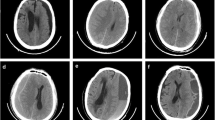Abstract
We did a prospective study of 70 adults with chronic subdural hematomas.
We looked at the correlation between some aetiological, clinical, and radiological factors and outcome.
The present analysis found a significant positive correlation of cephalea, isodense aspect of the hematoma at CT scan, and pulsatance of the encephalon at surgery to good clinical outcome.
Viceversa, alcoholism and intracranial hypotension associated with postoperative pneumocephalus are factors usually correlated with a negative clinical course.
Similar content being viewed by others
References
Aronson SM, H Okasaki: A study of some factors modifying response of cerebral tissue to subdural haematoma. J Neurosurg 20 (1963) 20, 89, 93
Bakey L, FE Glasauer: Chronic subdural haematoma in head injury. Little, Brown and Company 216 (1988) 228
Cameron MM: Chronic subdural haematoma: a review of 114 cases. J Neurol Neurosurg Psychiatr 41 (1978) 834–839
W Dreisen: Epidural and subdural haematoma as a complication of internal drainage of cerebrospinal fluid hydrocephalus. Acta Neurochir 30 (1974) 85–93
Fogelholm R, O Heiskamen, O Waltimo: Chronic subdural haematoma in adults. Influence of patient's age on symptoms signs and thickness of haematoma. J Neurosurg 42 (1975) 43–40
Gjerris F, K Schmidt: Chronic subdural haematoma. Surgery or mannitol treatment. J Neurosurg 40 (1974) 639–642
Hirsh LF: Intracranial air following subdural haematoma drainage with delayed recovery. Neurochirurgia 23 (1980) 55–58
Hubschmann OR: Twist-drill craniotomy in the treatment of chronic and subacute subdural haematomas in severely ill and elderly patients. Neurosurgery 6 (1980) 233–236
Ito H, M Maeda, T Vehara et al: Attenuation values of chronic subdural haematoma and subdural effusion in CT scans. Acta Neurochir 72 (1984) 211–217
Markwolder TM: Chronic subdural haematomas: a review. J Neurosurg 54 (1981) 637–645
Markwolder TM, KF Steinsiepe, M Rohner, W Reichenback, DC Mc Cullough, JL Fox: Negative intracranial pressure hydrocephalus in adults with shunts and its relationship to the production of subdural haematoma. J Neurosurg 40 (1974) 37, 375
Mousse AH, N Joshy: The impact of computed tomography on the treatment of chronic subdural haematoma. J Neurol Neurosurg Psychiatr 45 (1982) 1156–1158
Scotti G, K Terbrugge, D Melaneon, G Belanger: Evoluation of the age of subdural haematomas, by computerized tomography. J Neurosurg 47 (1977) 311–315
Tabaddor K, K Shulman: Definitive treatment of chronic subdural haematoma by twist-drill craniostomy and closed-system drainage. J Neurosurg 46 (1977) 220–226
Tomaszak, FY Tsai, JE Huprich, HD Segall, JS Teal: The contrast-enhanced CT scan in the diagnosis of isodense subdural haematoma. J Neurosurg 50 (1979) 64–69
Author information
Authors and Affiliations
Rights and permissions
About this article
Cite this article
Merlicco, G., Pierangeli, E. & di Padova, P.L. Chronic subdural hematomas in adults: prognostic factors. Analysis of 70 cases. Neurosurg. Rev. 18, 247–251 (1995). https://doi.org/10.1007/BF00383875
Received:
Accepted:
Issue Date:
DOI: https://doi.org/10.1007/BF00383875




